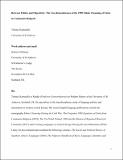Between politics and objectivity : the non-remembrance of the 1989 ethnic cleansing of Turks in communist Bulgaria
Abstract
Cold War Europe’s largest and most intensive act of ethnic cleansing, namely, the 1989 expulsion of Turks from communist Bulgaria, remains a neglected subject three decades on after the event. When it took place, the term “ethnic cleansing” had not been invented yet, so in light of international law this expulsion was a “population transfer.” Population transfers (even unilateral) were deemed legal until the mid-1990s. Subsequently, under the influence of the atrocities committed during the wars of Yugoslav succession, population transfers were criminalized and relabelled as “ethnic cleansings.” For a variety of reasons, the 1989 Ethnic Cleansing has been also neglected by scholars and politicians in both, Bulgaria and Turkey. The neglect continues to this day, despite the Bulgarian Parliament’s momentous 2012 Declaration, which officially recognized the expulsion as an act of ethnic cleansing. This Declaration – which could become a basis for successful Turkish-Bulgarian reconciliation – largely remains unknown in both countries, while the propagandistic terminology employed for referring to the 1989 Ethnic Cleansing deepens the oblivion and obfuscates the nature of this tragic event. Both, in Turkish and Bulgarian, official and scholarly terminology employed suggests – incorrectly – that it was a “kind of emigration.”
Citation
Kamusella , T 2020 , ' Between politics and objectivity : the non -remembrance of the 1989 ethnic cleansing of Turks in communist Bulgaria ' , Journal of Genocide Research , vol. Latest Articles . https://doi.org/10.1080/14623528.2020.1726649
Publication
Journal of Genocide Research
Status
Peer reviewed
ISSN
1462-3528Type
Journal article
Collections
Items in the St Andrews Research Repository are protected by copyright, with all rights reserved, unless otherwise indicated.

